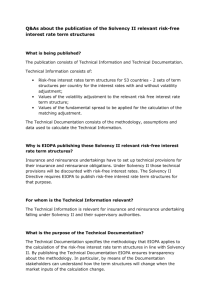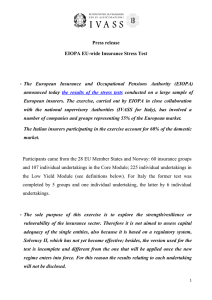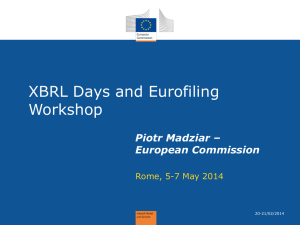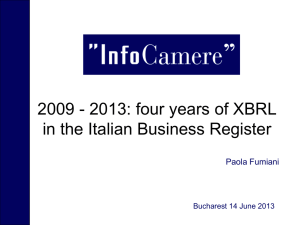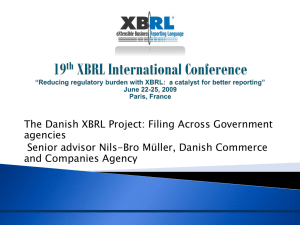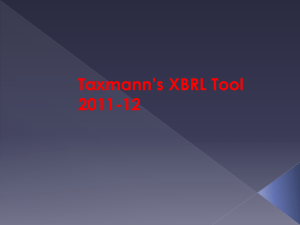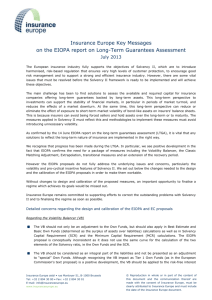EIOPA Update
advertisement
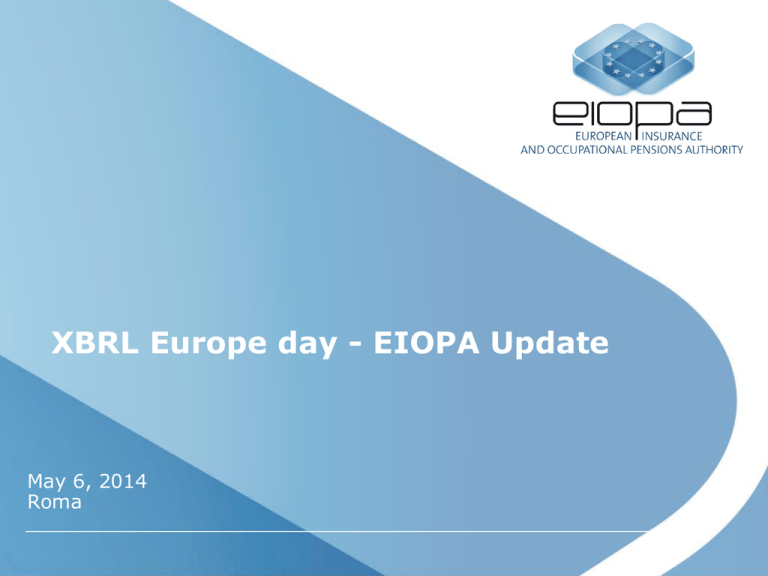
XBRL Europe day - EIOPA Update May 6, 2014 Roma Solvency II in 2009 • Solvency II seen end of 2009 • 4 levels o Framework directive [2009/138/CE - 25 November 2009] o Implementation measures (Commission – Delegated acts) o Guidelines (CEIOPS) o Monitoring proper working (Commission) o Entry in force on October 2012 Point sur les mesures de niveau 2 et 3 2 2 Solvency II seen now o Entry in force on the 1st of January 2016 - Day 1 reporting (April/May 2016) - First quarterly regular reporting (May/July 2016) - First annual regular reporting (May/June 2017) o A preparatory phase - Smaller (subset) reports compared to the full SII - One annual report on end 2014 basis (+20/26 weeks) - And one quarterly report on end Q3 2015 basis (+8/14 weeks) o Two supporting taxonomies - Preparatory phase (almost stable) - Final Solvency II (will stabilize over the next few months) 3 Solvency II – the evolution • http://ec.europa.eu/internal_market/insurance/solvency/future/index_en.htm • Compared to 2009: a new level: « 2.5 » Titre de la présentation 4 4 The level “2.5” • Lisbon Treaty o Entry in force just after Solvency II directive • Creation of EIOPA o Task in line with Lisbon Treaty • Omnibus II directive to adapt Solvency II Titre de la présentation 5 5 Expected content by levels • Level 2: Delegated acts (Commission) o Around 40 topics (end 2014 / beginning 2015). • Level 2.5: Technical standards (EIOPA proposal, COM adoption) o Regulatory o Implementing Reporting • Level 3: recommandations and guidelines (EIOPA) o Adressed to NSAs or undertakings o Non legally binding XBRL o « Comply or explain » 6 Titre de la présentation 6 The time dimension Jan-March ITS set 1 : “approval processes” 24.2 prepare for BOS for adoption for consultation at BOS end March 2014 April- June July Sept April - June: Consultation GL set 2 (Pillar 2, Pillar 3 and Supervisory issues) 3.10 prepare for BOS for adoption for consultation 1.4. prepare for BOS adoption for consultation Jan-March 2015 April- June July-Sept OctDec 31.10. submission to COM ITS set 2: “other” GL set 1 (Approval processes + Pillar 1, including internal models) Oct-Dec June Sept.: Consultat ion Dec.-Feb.: Consultation BOS approval end Nov. 3.10 prepare for BOS adoption for consultation 30.6. submission to COM 1.4 end complyexplain process Dec.– March: Consultation BOS approval end May 30.9 end complyexplain process 7 Preparatory phase • Omnibus 2 discussion suspended in the summer 2012 • EIOPA opinion (December 2012) • Consultation on guideline (March 2013), Published in November, In force since 1/1/2014 o Electronic format for reporting 8 Preparatory phase taxonomy • • • • V1 in November 2013 V1.2 in January V1.4 soon Stable V1.5 around end May. • • • • • Assertion gradually implemented V1.4 without an HD layer (issues on open tables) Localisation capabilities in V1.5 Manuals in V1.5 Sample instances 9 Betas release of Solvency II Taxonomy • To be aligned with the ITS • Recodification (row/column codes), use of codes for list of options, … • Some iterations, with growing content, until the final one 10 T4U: Main goals Internationalization: Languages, data formats, currencies, etc. Distribution license for all Europe. Preferable EUPL license Easy to use for administrative staff with limited IT knowledge Easy to deploy 2nd level support Using the input forms in a similar layout as the public reference templates. Use of XBRL label, rendering, reference, formulas, etc. Allowing reusing or extension of the tool for national extensions Easy to update when the taxonomy changes Open source, reusable XBRL syntax and formula validation at client side Good performance with large amounts of data Multiplatform 11 T4U: Ins and OUTs Easy-to-use with multiple Data Input Interfaces Generation of XBRL Reports according to Solvency II DPM XBRL Taxonomy (Level 1 & 2) XBRL Validation (open source component) for Reported Data XBRL load, validation and creation with database approach Support for other XBRL Architectures than EIOPA / Eurofiling Generation of XBRL Taxonomy according to Eurofiling Architecture DPM Database for Metadata and Data Basic BI analysis capabilities Reports and submissions management Adavanced data analysis Second-level support First-level support / support services for extensions 12 T4U: Characteristics • Open source (EUPL) • (Re)use of cross platform components • Design around an SQLite database extending EBA DPM database • Modular approach: a toolkit instead of a monolithic approach • Validation through a real XBRL engine possible o Arelle interface implemented o Database population by Arelle • Yesterday’s demo: o A windows tool implementation o An excel add-in implementation o A proof of concept of an iPad implementation 13 T4U: Schedule • Current planning o June (windows forms) o August (Excel add-in) o September (NCAs oriented capabilities) 14 Topics currently examined • Extensions (national, statistical needs, …) • Validation service • Clear shift of focus toward implementation ! 15 Thank you Pierre-Jean Vouette Pierre-Jean.Vouette@eiopa.europa.eu


